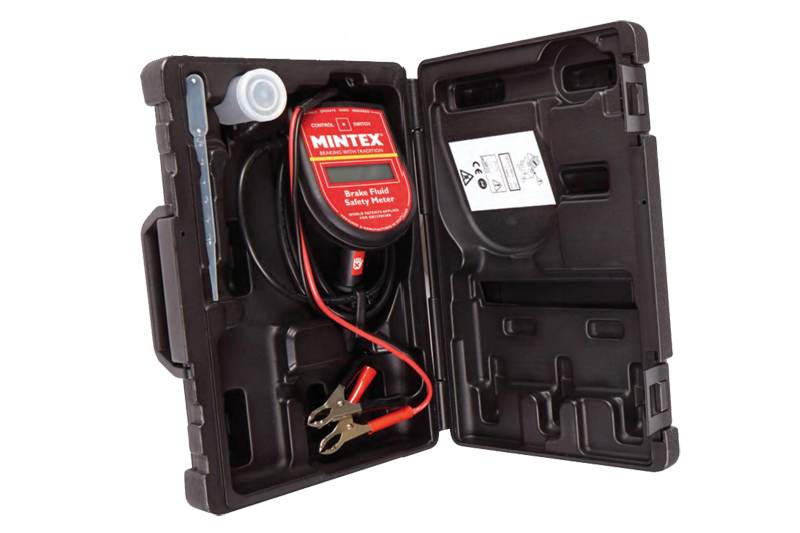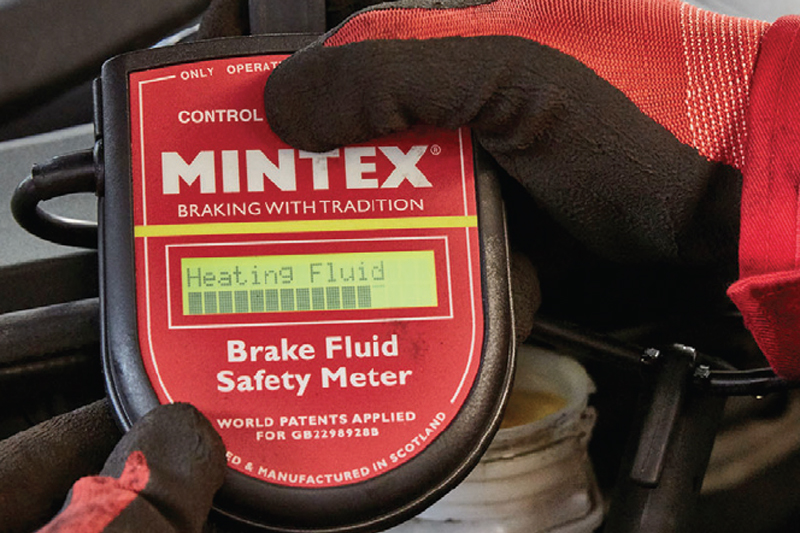
When it comes to vehicle maintenance, monitoring the condition of brake fluid rarely makes most drivers’ to-do lists. This can lead to dangerous consequences for motorists and a missed service opportunity for the trade. Here, Scott Irwin MIMI, Head of Technical Training at TMD Friction’s aftermarket brake brand, Mintex, discusses why both garages and motor factors need to educate their customers on this issue and the technicalities around each variation of brake fluid:
Motor factors and garages play an important part in keeping drivers safe on the road. Although most road users are au fait with the value of regular oil changes, the health of brake fluid is often ignored. This makes the role of garages, in particular, incredibly important in ensuring that a temperature test is conducted as part of a routine service.
The process of testing brake fluid is straightforward, and exact boiling points can be identified easily using a brake fluid tester.
Where possible, it is recommended to perform the test in the master cylinder reservoir of the car, by inserting the probe and ensuring its end sits just below the fluid level. Before performing the test, the equipment must be connected to the car battery, which is used to heat the brake fluid.
As with any equipment, it’s important to find a device that is easy to use. Depending on the kit, instructions will often be shown on-screen, which takes the operator through each stage of the process.
The Mintex brake fluid tester MTL1000 is particularly user-friendly and features an LCD screen to aid usability. As the car battery heats the brake fluid, the probe will take the temperature, which typically takes around 30 seconds.
Once the test is complete, the operator is left with an accurate brake fluid temperature reading. If necessary, ‘before’ and ‘after’ readings can be shown to customers to demonstrate the difference in fluid levels and the importance of the test.

Although most vehicle technicians will be familiar with performing a brake fluid test, best practice around storing the product and the different variations available may be lesser known. As brake fluid is essentially the life blood of the braking system, it’s crucial that garages are fully aware of how to use it, store it and mix it.
With regard to the different variations of brake fluids, the solution uses an American DOT system set out by the Society of Automotive Engineers and the Department of Transportation.
There are many different types: DOT 3, DOT 4, DOT 4LV, DOT 5 and DOT 5.1, with the main difference between them being the temperature at which they boil. Technicians should always use the fluid type specified by the vehicle manufacturer to avoid mixing each variation. It is possible to mix some glycol-based fluids but never DOT 5, as this is silicone-based.
The difference between glycol-based and silicone-based fluids is an important distinction to make. Glycol-based fluids are hygroscopic, which means that they naturally absorb water from the environment at normal atmospheric pressure.
When brake fluid is in a vehicle, water will find its way through microscopic pores in brake hoses, seals and joints. Even when it’s on the shelf, unopened bottles can absorb moisture from the atmosphere and should not be kept on the shelf for long periods of time.

It is also essential that brake fluid is kept airtight, which is why standard bottles of brake fluid are 1.25l. This means that an entire bottle is used per one brake fluid fill, to ensure that nothing is left on the shelf and susceptible to moisture contamination.
How does this actually affect the brake fluid?
There are advantages and disadvantages: the upshot, water is heavier than brake fluid, so when it enters the product, one would expect it to pool and settle in low spots and boil very easily – this isn’t the case! Due to its hygroscopic nature, water is dispersed throughout the fluid, which helps to keep the boiling point of the brake fluid higher for longer.
It also prevents internal corrosion, which wouldn’t happen if the water was allowed to pool. The downside is that, ultimately, the presence of water within brake fluid will lower the boiling point over time. If the fluid temperature gets too low, it becomes extremely dangerous, and can lead to complete brake system failure.
There is one fluid that is set apart from the rest and that’s DOT 5. This product is silicone-based, meaning it is hydrophobic as opposed to hygroscopic and will not absorb water. As water isn’t absorbed by this fluid, DOT 5 is considered to have a very long lifespan and is commonly used in vehicles that need to be stored for long periods of time but ready to go at the drop of a hat, such as military vans and classic cars.
Importantly, although silicone-based brake fluids do not absorb water, it can still enter the system and, therefore, lower the boiling point. Because water cannot be absorbed by hydrophobic solutions it will not disperse throughout the product. Instead, it will pool and settle in low spots and reduce the whole temperature of the braking system to 100°C, as well as potentially cause corrosion.
This, along with the fact that silicone-based fluids cannot be mixed, is invaluable knowledge. Although silicone-based fluids will generally last longer, they do need changing, and it’s important to refer to the manufacturer’s recommendations on how to test and change this type of fluid.
The importance of testing brake fluid can be seen as inconsequential, but this couldn’t be further from the truth! The dangers associated with driving a vehicle running on old brake fluid can be life-threatening, and this needs to be taken seriously by both motor factors and garages. Regularly testing brake fluid not only maximises opportunities for upselling a routine service, but it could also potentially save a life, and this test needs to be seen as a standard check that is critical to the health of a vehicle.







